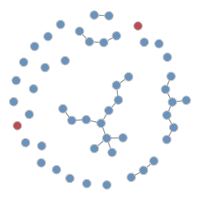34 Lab
In this lab, you can work to simulate a network-based epidemic model with demography (births and deaths).
34.1 Setup
Once you are ready, start out by clearing your R object environment, to make sure that you do not have any objects lingering from the tutorial. This can be accomplished with:
34.2 Lab Steps
In the Module Demography Tutorial, we first used a homogeneous and relatively low mortality rate (0.001). In the lab, either explore what happens to the model and network structure with further changes to the mortality rate and birth (arrival) rate; or experiment with the degree heterogeneity and mixing parameters featured in that model.
Assume a slightly growing population. Instead of modeling the
a.rateas the same value as the death rates, use a slightly higher value (e.g.,0.0015) but keep the death rates at0.001. Do you need to adjust thedissolution_coefsparameterization here? What happens to the overall population structure (population size) and network structure (edgesandmeandegpost-simulation diagnostics)?Use the original arrival/birth rate, but assume a higher overall death rates with disease-related mortality:
ds.rate = 0.0012anddi.rate = 0.0025. Figure out how to parameterize thed.rateargument indissolution_coefswith some trial and error: first start by taking the simple average, and then experiment with higher values that better keep the network diagnostics in check.Instead of parameterizing the network with a higher mean degree for risk group 1 and strong within-group mixing, take the approach of the Feedback Through Nodal Attribute Changes tutorial and assume one but not the other (i.e., mean degree homogeneity but assortative mixing, or mean degree heterogeneity but proportional mixing), and compare the results to the tutorial outputs?
